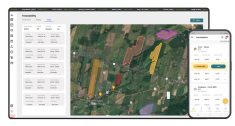When IP soybeans are shipped from where many of them are grown in southern Ontario they leave in shipping containers destined for Europe or Asia.
Why it matters: A container port close to growers in southwestern Ontario could increase export opportunities.
They’re mostly loaded on intermodal transport trucks or trains which have to get through the traffic gridlock of Toronto before continuing to Trois Rivieres or Quebec City, where the containers are loaded onto ocean-going ships.
As Canada considers projects of national interest, Ontario agriculture could ship more, reduce traffic through Toronto and increase efficiency with a container port on the Great Lakes.
The business case wouldn’t be clearcut, say Ontario agriculture commodity companies and organizations, with a supply of inbound containers needed, and the annual closure of the Great Lakes to shipping during winter.
A container port, however, is a topic of conversation among the province’s agriculture commodity exporters.
“Several of our key crops, including soybeans and wheat, are shipped to global customers in containers — a process that currently relies on rail and truck transport,” says Paul Hoekstra, vice president of strategic development for Grain Farmers of Ontario.
“We encourage government and private-sector partners to explore and prioritize this opportunity as part of broader efforts to modernize and diversify Canada’s trade infrastructure.”
Hamilton’s Pier 25 has seen significant development in the past several years with public and private sector investments in commodity and food product infrastructure. That includes a new rail translocation yard at Pier 25 and direct intermodal rail service between Hamilton and Montreal. Companies such as Parrish & Heimbecker have also made investments in Hamilton and in its Picton terminal, in addition to acquiring a bulk marine export terminal in Quebec City.
Such investments come at a time when Ontario Premier Doug Ford and his government are continuing to drive economic development in the face of aggression from the United States.
Prime Minister Mark Carney is also encouraging the upgrading of transportation corridors and ports to get more Canadian goods to market.
That’s prompted more discussion of the feasibility of a full container port on the Great Lakes and the improved market access it could bring for commodities like food grade soybeans and dry beans.
A Great Lakes container port could also be used for shipping meat and other consumer goods that now have to go to ocean ports.
Hoekstra says the GFO is behind the idea of a true Great Lakes container port, given the new market opportunities and general competitive boost it would afford. It would also support logistical flexibility for Ontario grain farmers and the entire value chain.
Brad Chandler, chief executive officer for Hensall Co-op, a leader in the production of speciality beans agrees that a container port would be a major boon, bringing improved access to markets in Europe, the United Kingdom, and southeast Asia.
This assumes a container port will bring efficiencies as well as export capacity.
“It’s all about service and serviceability,” says Chandler, citing frequency of service, terminal hours, seaway closure during winter, and other factors to consider. Access to empty containers matters too. If traders will still need to acquire empty containers from one location and move them to the container port, for example, the value of the port may not be fully realized. Still, he reiterates “the concept is real.”
“Once again it all comes down to cost, and efficiencies and creating the market.”
Significant as they are, agricultural commodities may not be what spurs the development of a container port – at least, not on their own.
Russel Hurst, chief executive officer of the Ontario Agri Business Association, says agriculture commodities currently comprise about one-third of tonnage shipped from the Port of Hamilton, for example. Although he adds this is up from “single digits” two decades ago – the change is partially a result of declines in the steel industry. Container capacity would likely mean the movement to-and-fro of higher value products, compared to what is generally moved in bulk.
“We’re exporting. Theres not a lot of containers inbound with agricultural commodities in them…If there are more options, the better,” says Hurst. The timing of container shipping, though, can be a challenge.
“If you put it on a truck and drive somewhere…you know when you can ship it and expect it to be delivered. The time window for rail or marine is wider. It’s more like ‘it will be here this week,’ or something of that nature,” he says.
“Sometimes one of the biggest challenges is the logistics of moving crops. Especially high value crops.”
Hamilton as a growing agriculture commodity export port would be one option for the location of a port west of Toronto. Windsor is also a significant port, and Goderich is the only port on the east side of Lake Huron. It’s already a significant grains export terminal.
East of Toronto there are ports in Oshawa, Johnstown (which has expanded its capacity with a fertilizer component receiving partnership recently announced with V6 Agronomy) and Picton, where new grain exporting capacity is being built.















